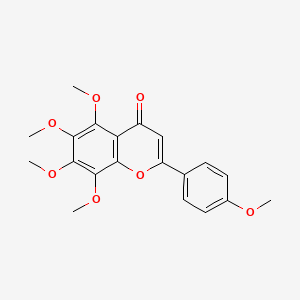| MeSH term | MeSH ID | Detail |
|---|---|---|
| Diabetes Mellitus | D003920 | 90 associated lipids |
| Lung Neoplasms | D008175 | 171 associated lipids |
| Reperfusion Injury | D015427 | 65 associated lipids |
| Mammary Neoplasms, Experimental | D008325 | 67 associated lipids |
| Hypercholesterolemia | D006937 | 91 associated lipids |
| Thrombosis | D013927 | 49 associated lipids |
| Neuroblastoma | D009447 | 66 associated lipids |
| Carcinoma, Hepatocellular | D006528 | 140 associated lipids |
| Carcinoma, Ductal, Breast | D018270 | 19 associated lipids |
| Parkinson Disease | D010300 | 53 associated lipids |
Tangeretin
Tangeretin is a lipid of Polyketides (PK) class. Tangeretin is associated with abnormalities such as Cardiovascular Diseases, Complex Regional Pain Syndromes, Blood Clot, Hypercholesterolemia and Restenosis. The involved functions are known as Thrombus, Platelet function, Localized desquamation, Platelet Activation and Signal. Tangeretin often locates in Protoplasm, Cytoplasmic Granules, Cytoplasmic matrix, Plasma membrane and Blood. The associated genes with Tangeretin are GP6 gene, CDK2 gene, CDK6 gene, Tumor Suppressor Genes and CDH1 gene. The related lipids are Lipopolysaccharides. The related experimental models are Mouse Model and Transgenic Model.
Cross Reference
Introduction
To understand associated biological information of Tangeretin, we collected biological information of abnormalities, associated pathways, cellular/molecular locations, biological functions, related genes/proteins, lipids and common seen animal/experimental models with organized paragraphs from literatures.
What diseases are associated with Tangeretin?
Tangeretin is suspected in Complex Regional Pain Syndromes, Cardiovascular Diseases, Blood Clot, Hypercholesterolemia, Restenosis and other diseases in descending order of the highest number of associated sentences.
Related references are mostly published in these journals:
| Disease | Cross reference | Weighted score | Related literature |
|---|
Possible diseases from mapped MeSH terms on references
We collected disease MeSH terms mapped to the references associated with Tangeretin
PubChem Associated disorders and diseases
What pathways are associated with Tangeretin
There are no associated biomedical information in the current reference collection.
PubChem Biomolecular Interactions and Pathways
Link to PubChem Biomolecular Interactions and PathwaysWhat cellular locations are associated with Tangeretin?
Visualization in cellular structure
Associated locations are in red color. Not associated locations are in black.
Related references are published most in these journals:
| Location | Cross reference | Weighted score | Related literatures |
|---|
What functions are associated with Tangeretin?
Related references are published most in these journals:
| Function | Cross reference | Weighted score | Related literatures |
|---|
What lipids are associated with Tangeretin?
Related references are published most in these journals:
| Lipid concept | Cross reference | Weighted score | Related literatures |
|---|
What genes are associated with Tangeretin?
Related references are published most in these journals:
| Gene | Cross reference | Weighted score | Related literatures |
|---|
What common seen animal models are associated with Tangeretin?
Mouse Model
Mouse Model are used in the study 'Methoxyflavones protect cells against endoplasmic reticulum stress and neurotoxin.' (Takano K et al., 2007) and Mouse Model are used in the study 'Influence of tangeretin on tamoxifen's therapeutic benefit in mammary cancer.' (Bracke ME et al., 1999).
Transgenic Model
Transgenic Model are used in the study 'Methoxylated flavones, a superior cancer chemopreventive flavonoid subclass?' (Walle T, 2007).
Related references are published most in these journals:
| Model | Cross reference | Weighted score | Related literatures |
|---|
NCBI Entrez Crosslinks
All references with Tangeretin
Download all related citations| Authors | Title | Published | Journal | PubMed Link |
|---|---|---|---|---|
| Kim GS et al. | Citrus aurantium flavonoids inhibit adipogenesis through the Akt signaling pathway in 3T3-L1 cells. | 2012 | BMC Complement Altern Med | pmid:22471389 |
| Walsky RL et al. | Optimized assays for human UDP-glucuronosyltransferase (UGT) activities: altered alamethicin concentration and utility to screen for UGT inhibitors. | 2012 | Drug Metab. Dispos. | pmid:22357286 |
| Mulvihill EE and Huff MW | Protection from Metabolic Dysregulation, Obesity, and Atherosclerosis by Citrus Flavonoids: Activation of Hepatic PGC1α-Mediated Fatty Acid Oxidation. | 2012 | PPAR Res | pmid:22701469 |
| Lee DH et al. | Flavonoids Isolated from Korea Citrus aurantium L. Induce G2/M Phase Arrest and Apoptosis in Human Gastric Cancer AGS Cells. | 2012 | Evid Based Complement Alternat Med | pmid:22194772 |
| Furukawa Y et al. | Isolation and characterization of activators of ERK/MAPK from citrus plants. | 2012 | Int J Mol Sci | pmid:22408427 |
| Weng CJ and Yen GC | Flavonoids, a ubiquitous dietary phenolic subclass, exert extensive in vitro anti-invasive and in vivo anti-metastatic activities. | 2012 | Cancer Metastasis Rev. | pmid:22314287 |
| Vauzour D | Dietary polyphenols as modulators of brain functions: biological actions and molecular mechanisms underpinning their beneficial effects. | 2012 | Oxid Med Cell Longev | pmid:22701758 |
| Meiyanto E et al. | Natural products for cancer-targeted therapy: citrus flavonoids as potent chemopreventive agents. | 2012 | Asian Pac. J. Cancer Prev. | pmid:22524801 |
| Kostrzewa-Susłow E and Janeczko T | Microbial transformations of 7-hydroxyflavanone. | 2012 | ScientificWorldJournal | pmid:22654578 |
| Chen HF et al. | Simultaneous quantification of polymethoxylated flavones and coumarins in Fructus aurantii and Fructus aurantii immaturus using HPLC-ESI-MS/MS. | 2012 | J Pharm Biomed Anal | pmid:22071443 |
